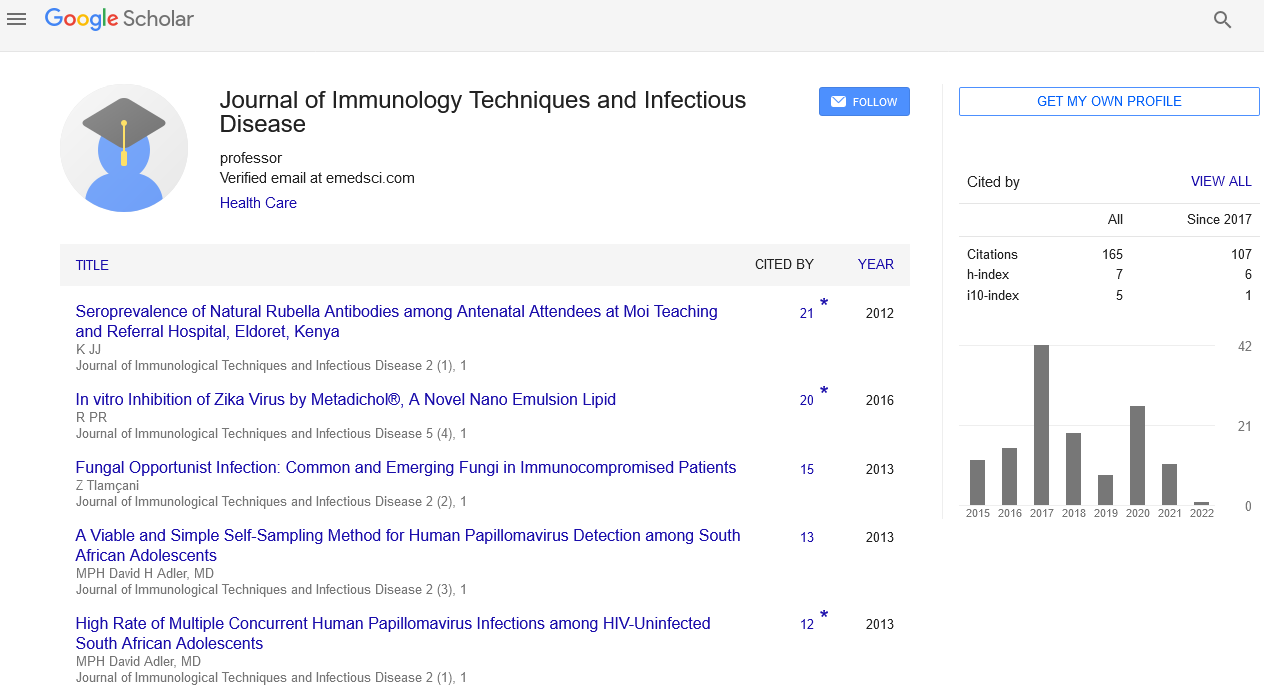Short Communication, J Immunol Tech Infect Dis Vol: 13 Issue: 1
Immunization Techniques: Vaccine Administration, Innovations and Advances
Kimm Hanbii*
1Department of Medicine, University of Miami Miller School of Medicine, Miami, USA
*Corresponding Author: Kimm Hanbii,
Department of Medicine, University of
Miami Miller School of Medicine, Miami, USA
E-mail: han.kim@gmail.com
Received date: 01 March, 2024, Manuscript No. JIDIT-24-135098;
Editor assigned date: 04 March, 2024, PreQC No. JIDIT-24-135098 (PQ);
Reviewed date: 18 March, 2024, QC No. JIDIT-24-135098;
Revised date: 26 March, 2024, Manuscript No. JIDIT-24-135098 (R);
Published date: 04 April, 2024, DOI: 10.4172/2329-9541.1000367.
Citation: Hanbii K (2024) Immunization Techniques: Vaccine Administration, Innovations and Advances. J Immunol Tech Infect Dis 13:1.
Description
Immunization stands as one of the most effective public health interventions, preventing millions of deaths from infectious diseases each year. Central to the success of immunization programs are the techniques and methods employed to administer vaccines safely and effectively [1-3].
Vaccine administration
The administration of vaccines involves more than the act of injecting a needle. It encompasses a series of steps aimed at ensuring vaccine safety, efficacy, and patient comfort. Healthcare professionals must adhere to proper injection techniques, including site selection, needle size, injection angle, and depth, to minimize pain, tissue trauma, and adverse reactions. Additionally, the use of appropriate injection sites, such as the deltoid muscle for intramuscular injections and subcutaneous tissue for certain vaccines, optimizes vaccine absorption and immune response.
Patient-centered methods
Effective communication and patient engagement are essential components of successful immunization programs. Healthcare providers must employ patient-centered approaches, addressing vaccine hesitancy, concerns, and misconceptions, and providing clear, evidence-based information about the benefits and safety of vaccination. Developing relationships and establishing confidences with patients and families increase optimism in immunization recommendations, this results in increased vaccination acceptability and completion rates [4-6].
Special considerations for pediatric and adult populations
Immunization techniques may vary depending on the age, health status, and vaccination history of individuals. Pediatric vaccinations require careful attention to dose calculation, needle size selection, and distraction techniques to minimize discomfort and anxiety in young children. Conversely, adult vaccinations may involve considerations such as vaccination schedules, catch-up doses, and booster shots to maintain immunity against vaccine-preventable diseases. Tailoring immunization techniques to specific age groups and populations ensures optimal vaccine delivery and protection [7,8].
Injection site management and adverse event monitoring
Proper injection site management is essential for monitoring adverse events and ensuring vaccine safety and efficacy. Healthcare providers must document vaccine administration details, including vaccine type, expiration date, injection site, and adverse reactions, in patient records or immunization registries. Post-vaccination counseling and observation periods enable healthcare professionals to monitor for immediate adverse reactions, such as allergic reactions or syncope, and provide timely intervention if necessary [9,10].
Cold chain management: Preserving vaccine potency
Maintaining the cold chain is essential for preserving vaccine potency and efficacy throughout the vaccine distribution and administration process. Vaccines are sensitive biological products that require minimum temperature control from manufacturing to administration. Healthcare facilities must adhere to cold chain protocols, including proper storage, handling, monitoring, and transport of vaccines within recommended temperature ranges. Innovations such as cold chain monitoring devices, temperaturesensitive labels, and vaccine storage refrigerators enhance cold chain management and ensure vaccine integrity.
Innovations and advances in immunization techniques
Advancements in vaccine delivery technologies are transforming immunization techniques and expanding access to vaccines around the world. Needle-free delivery systems, micro-needle patches, and jet injectors provide painless, convenient alternatives to traditional needle-based injections, particularly in pediatric and needle-phobic populations. Novel vaccine formulations, such as adjuvanted vaccines and mucosal vaccines, enhance immunogenicity and enable targeted immune responses against specific pathogens. Furthermore, digital health technologies, including electronic immunization registries, reminder systems, and vaccine tracking apps, streamline immunization workflows and improve vaccination coverage rates.
Immunization methods are important for the success of vaccination programmes, ensuring that vaccinations are delivered safely and effectively to people of all ages. Healthcare workers may improve vaccine delivery, increase vaccination acceptability, and protect populations from vaccine-preventable illnesses by using patientcentered methods, adhering to best practices in vaccine administration, and utilizing technology developments. As vaccine studies continue and delivery technologies develop, understanding the latest developments of immunization will remain essential in obtaining global health equity and preventing infectious disease epidemics.
References
- Liu K, Iyoda T, Saternus M, Kimura Y, Inaba K, et al (2002) Immune tolerance after delivery of dying cells to dendritic cells in situ. J Exp Med. 196(8):1091-1097.
- Audiger C, Rahman MJ, Yun TJ, Tarbell KV, Lesage S (2017) The importance of dendritic cells in maintaining immune tolerance. J Immunol. 198(6):2223-31.
- Hasegawa H, Matsumoto T (2018) Mechanisms of tolerance induction by dendritic cells in vivo. Front Immunol. 9:350.
- Donnelly JJ, Liu MA, Ulmer JB (2000) Antigen presentation and DNA vaccines. American journal of respiratory and critical care medicine.162:S190-193.
- Bot A, Stan AC, Inaba K, Steinman R, Bona C (2000) Dendritic cells at a DNA vaccination site express the encoded influenza nucleoprotein and prime MHC class I-restricted cytolytic lymphocytes upon adoptive transfer. Int Immunol. 12(6):825-832.
- Smith TR, Schultheis K, Kiosses WB, Amante DH, Mendoza JM, et al (2014) DNA vaccination strategy targets epidermal dendritic cells, initiating their migration and induction of a host immune response. Mol Ther Methods Clin Dev. 1:14054.
- Shi GX, Harrison K, Han SB, Moratz C, Kehrl JH (2004) Toll-like receptor signaling alters the expression of regulator of G protein signaling proteins in dendritic cells: implications for G protein-coupled receptor signaling. J Immunol. 172(9):5175-5184.
- Strange PG (2008) Agonist binding, agonist affinity and agonist efficacy at G protein‐coupled receptors. Br J Pharmacol. 153(7):1353-1363.
- Charlton SJ (2009) Agonist efficacy and receptor desensitization: from partial truths to a fuller picture. Br J Pharmacol. 158(1):165-168.
- Pollard C, De Koker S, Saelens X, Vanham G, Grooten J (2013) Challenges and advances towards the rational design of mRNA vaccines. Trends Mol Med. 19(12):705-713.
 Spanish
Spanish  Chinese
Chinese  Russian
Russian  German
German  French
French  Japanese
Japanese  Portuguese
Portuguese  Hindi
Hindi 
